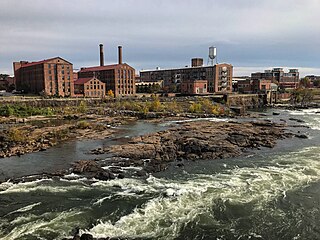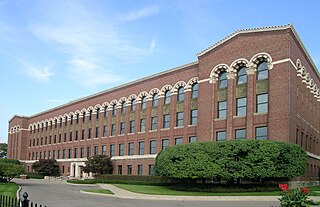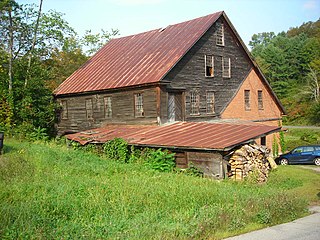
Muscogee County is a county located on the central western border of the U.S. state of Georgia named after the Muscogee that originally inhabited the land with its western border with the state of Alabama that is formed by the Chattahoochee River. As of the 2020 census, the population was 206,922. Its county seat and only city is Columbus, with which it has been a consolidated city-county since the beginning of 1971.

Chattahoochee County, also known as Cusseta-Chattahoochee County, is a county located on the western border in central Georgia. As of the 2020 census, the population was 9,565. The county seat is Cusseta, with which the county shares a consolidated city-county government. The city of Cusseta remains a geographically distinct municipality within Chattahoochee County. The county was created on February 13, 1854.

Columbus is a consolidated city-county located on the west-central border of the U.S. state of Georgia. Columbus lies on the Chattahoochee River directly across from Phenix City, Alabama. It is the county seat of Muscogee County, with which it officially merged in 1970; the original merger excluded Bibb City, which joined in 2000 after dissolving its own city charter.

Saint Anthony Falls, or the Falls of Saint Anthony, located at the northeastern edge of downtown Minneapolis, Minnesota, was the only natural major waterfall on the Mississippi River. Throughout the mid-to-late 1800s, various dams were built atop the east and west faces of the falls to support the milling industry that spurred the growth of the city of Minneapolis. In 1880, the central face of the falls was reinforced with a sloping timber apron to stop the upstream erosion of the falls. In the 1950s, the apron was rebuilt with concrete, which makes up the most visible portion of the falls today. A series of locks were constructed in the 1950s and 1960s to extend navigation to points upstream.

The Chattahoochee River is a river in the Southeastern United States. It forms the southern half of the Alabama and Georgia border, as well as a portion of the Florida and Georgia border. It is a tributary of the Apalachicola River, a relatively short river formed by the confluence of the Chattahoochee and Flint rivers and emptying from Florida into Apalachicola Bay in the Gulf of Mexico. The Chattahoochee River is about 430 miles (690 km) long. The Chattahoochee, Flint, and Apalachicola rivers together make up the Apalachicola–Chattahoochee–Flint River Basin. The Chattahoochee makes up the largest part of the ACF's drainage basin.

The Augusta Canal is a historic canal located in Augusta, Georgia, United States. The canal is fed by the Savannah River and passes through three levels in suburban and urban Augusta before the water returns to the river at various locations. It was devised to harness the water power at the fall line of the Savannah River to drive mills, to provide transportation of goods, and to provide a municipal water supply. It is the only canal in the US in continuous use for its original purposes of providing power, transport, and municipal water.
The W. C. Bradley company is an American manufacturer of consumer goods. It comprises four companies based on home and leisure products and services: Char-Broil, Lamplight, and W. C. Bradley Co. Real Estate.

Horace King was an African-American architect, engineer, and bridge builder. King is considered the most respected bridge builder of the 19th century Deep South, constructing dozens of bridges in Alabama, Georgia, and Mississippi. King was born into slavery on a South Carolina plantation in 1807. A slave trader sold him to a man who saw something special in Horace King. His enslaver, John Godwin, taught King to read and write as well as how to build at a time when it was illegal to teach enslaved people. King worked hard, and despite bondage, racial prejudice, and many obstacles, he focused on working hard and being a genuinely good man. King built bridges, warehouses, homes, and churches. Horace King became a highly accomplished Master Builder and emerged from the Civil War as a legislator in the State of Alabama. Affectionately known as Horace "The Bridge Builder" King and the "Prince of Bridge Builders", he also served his community in many important civic capacities."
Girard, Alabama was a city in the far north-east corner of Russell County, Alabama across the Chattahoochee River from Columbus, Georgia.

North Highlands Dam is a structure on the Chattahoochee River at the northern edge of the Columbus, Georgia, United States. It is approximately 4.2 miles (6.8 km) north of 9th Avenue in downtown Columbus. The dam was built in 1899 to provide power for the former Bibb City Mill. It was one of the first large dams constructed in the South. The North Highlands Dam was owned by the Columbus Electric and Power Company, until that utility was purchased by Georgia Power in 1930.

City Mills Dam was a dam on the Chattahoochee River, between Downtown Columbus, Georgia, and Phenix City, Alabama. The dam was built in 1907 to power the City Mills grist mill. Previously, a wooden dam dating to 1828 had existed at the site. The dam impounded a 1.3-mile (2.1 km) run of the river reservoir of approximately 110 acres (0.45 km2).

The Eagle and Phenix Dam was a stone dam on the Chattahoochee River, in downtown Columbus, Georgia. The dam was built in 1882 to power the Eagle and Phenix Textile Mill. It was located just south of the 13th Street Bridge connecting Columbus to Phenix City, Alabama. The dam produced a 45-acre (18 ha) run of the river reservoir that extended approximately 1 mile (1.6 km) upstream.

The historic River Place is located in Detroit, Michigan, bounded by Joseph Campau Avenue, Wight Street, McDougall Street, and the Detroit International Riverfront. It was formerly the Parke-Davis and Company Pharmaceutical Plant. The complex was listed on the National Register of Historic Places in 1985.

The Chattahoochee RiverWalk is a 22-mile walking and biking area along the Chattahoochee River in Columbus, Georgia, United States. The trail is paved with asphalt, concrete, or brick. Due to the RiverWalk bike path, Columbus has been listed by the League of American Bicyclists as one of the forty most Bicycle Friendly Communities in the United States.

Downtown Columbus, Georgia, also called "Uptown", is the central business district of the city of Columbus, Georgia. The commercial and governmental heart of the city has traditionally been toward the eastern end of Downtown Columbus, between 10th Street and 1st Avenue. Recent developments, particularly between Broadway and 2nd Avenue, have expanded the boundaries of the "central" part of the neighborhood. The term "Downtown Columbus" can also mean this smaller, more commercial area, particularly when used in the context of the city's nightlife and restaurants.

The Bennington Village Historic District of Bennington, New Hampshire encompasses the 19th-century center of the village. Growth of the village followed a typical pattern for rural New Hampshire towns, based in this case around the growth in the early 19th century of the paper industry, which continues to be a significant economic force in the community. The district is centered on the junctions of Main, Center, and School Streets with Bible Hill Road and Francestown Road. The district was listed on the National Register of Historic Places in 2010.

The Hayward and Kibby Mill, also known as the Tunbridge Mill, is a historic industrial facility on Spring Road in Tunbridge, Vermont. It includes a substantially complete water-powered 19th-century grist mill dating back to 1820, with a later sawmill added about 1870. It is one of the few surviving water-powered mills in the state, and is believed to be the only one featuring both a sawmill and grist (grain) mill. It was listed on the National Register of Historic Places in 1992.
The following is a timeline of the history of the city of Columbus, Georgia, US.

The Thresher Mill is a historic industrial facility on West Barnet Road in Barnet, Vermont. First developed in 1836, it was the last water-powered mill to operate on the Stevens River, lasting into the late 20th century. The property, which includes an original mill dam and a surviving 1872 mill building, as well as archaeological sites of other industrial buildings, was listed on the National Register of Historic Places in 1996. It is now styled Ben's Mill, and is a local museum.
St. Anthony Falls in Minneapolis, Minnesota, is the only natural falls on the Mississippi River. Since almost the beginning of settlement in the area by European descendants, the St. Anthony Falls have been used for waterpower. The first allowed settlers were at Ft. Snelling, where construction began in 1820. A sawmill was operating 1821 and a flour mill in 1823. As soon as the land at the sides of the falls became available it was purchased with the intent of using the waterpower of the falls. First lumber mills covered the falls, cutting lumber floated down the Mississippi. After 1870 flour mills started to dominate the area. From 1880 to 1930 the area was the number one flour producer in the US. In later years, some of the power came from steam, but in 1923 half of the waterpower used was for flour milling. Other industries have also used the waterpower.

















